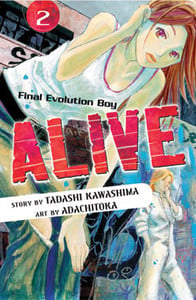Review
by Carlo Santos,Alive
GN 2
| Synopsis: |  |
||
After a mysterious string of suicides and murders around the world, Taisuke Kanou considers himself lucky just to be alive. But he still recalls the voice in his head that ordered him to die, and his classmates from school have also changed in strange ways: Taisuke's best friend Hirose has gone on a power trip and kidnapped his childhood friend Megumi. With only the barest of clues, Taisuke heads north to find them, but along the way he runs into "comrades"—survivors of the worldwide massacre who have developed deadly powers. Why do the "comrades" want to kill? And why are they out to get Taisuke? An even greater mystery comes when Taisuke discovers that he, too, has powers of his own... |
|||
| Review: | |||
From its description, Alive sounds like the typical shock-and-awe apocalyptic thriller—yet the story carries itself with a surprising degree of levelheadedness. Even as the stakes are raised in the second volume, it rarely plunges into all-out action and violence; the occasional moments of bloodshed are all the more heightened because they're so rare. The slice-of-life surface, combined with the circumstances of the story, create an unsettling feeling: how can these scenes of suburban Japan look so normal when there are terrible things happening right now? Such is the disturbing contradiction of Alive, and with the story gaining momentum, it looks like there will be plenty more secrets and horrors to uncover. The beginning of this volume picks up from the previous one with plenty of unanswered questions, from the countless deaths around the world to the bizarre behavior of Taisuke's friends. As it turns out, most of the thrill comes from these mysteries and mind games rather than pure action: How will Taisuke reach his friends? What are the intentions of the "comrades"? How can he defend himself against their abilities? Fortunately the answers to these questions start to pop up as the volume progresses: Taisuke meets a trucker headed north, he meets a "comrade" who isn't completely hellbent on destroying him, and he starts to understand how his own powers work. Readers, too, will start to understand the big picture as other characters relate their own experiences. The little boy that Taisuke meets provides some much-needed poignancy, balancing out the doom and gloom elsewhere. However, this volume also ends up creating just as many new questions as the ones it answered, and while that's probably good for keeping the suspense going, it can also be irritating for those who simply want to know what's going on. The occasional glimpses of Megu and Hiro don't help much—all we ever learn is that they're currently in hiding under the care of another superpowered baddie, and Hiro is losing is mind. Thus the story's greatest strength also becomes its greatest weakness: it refuses to reveal all the cards, and in doing so keeps readers interested but also frustrated. The story may not seem slow-paced while reading it—Taisuke is always on the move, and a couple of fights fill the necessary action quota—but after realizing how little has been revealed after the second volume, it does feel like it's taking forever to get anywhere. The clean, sharp-lined art provides an unusual counterpoint to Taisuke's dire circumstances; one would think that a world in crisis would look more gritty and blood-stained than this. Don't worry, there's some blood after all—but these gory moments happen just a handful of times in the book, which makes them all the more shocking when they come up. The depictions of suburban Japanese life are so ordinary that when a gruesome beheading pops out of nowhere, it's a disturbing experience on both a visual and cerebral level. Perhaps the style is too ordinary, though: Taisuke's character design is completely forgettable once the book is closed, and the same might be said of his supporting cast; meanwhile, the environments are depicted as bland expanses of buildings and greenery. In the end, only the action scenes remain memorable, with the characters' powers leading to some striking visual effects. Dialogue takes a secondary role throughout this story, as most things happen through "showing" (that is, Taisuke's actions and decisions) rather than "telling." Most conversation occurs in a plain, everyday tone, although it occasionally reaches higher levels as some characters wax philosophical about the nature of death and the emergence of their strange powers. The translation also retains a couple of culturally unique Japanese phrases in the text ("Itadakimasu" being the most obvious example), but the glossary in the back explains all of them anyway, as well as a couple of other notes regarding everyday life in Japan. What's good about this volume of Alive is that the mysteries of the "suicide virus" are starting to become clearer, and the story is definitely going somewhere. Unfortunately, it seems to be getting there at a frustratingly slow pace, as our hero takes his sweet time figuring out how to reach his friends and trying to understand exactly what's happening to him. At least there are some visceral action scenes to keep the excitement up, and the sight of such bloodshed against an ordinary, modern-day setting reminds us that this thriller means serious business. Are there greater perils in store for Taisuke? The last few pages in the book would suggest so. It might be a long time before he ever gets his friends back, or even makes sense of what's happening around the world, but following his adventure is a gripping experience nonetheless. |
| Grade: | |||
|
Overall : B-
Story : B-
Art : B
+ Suspense builds up as we get deeper into the story, punctuated by some brutal action scenes. |
|||
| discuss this in the forum (4 posts) | | |||
| Production Info: | ||
|
Full encyclopedia details about Release information about |
||